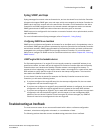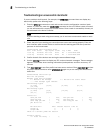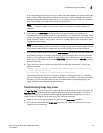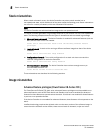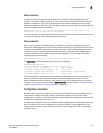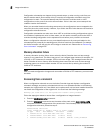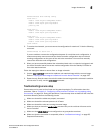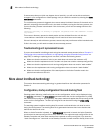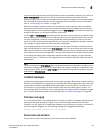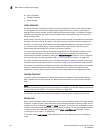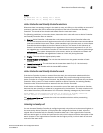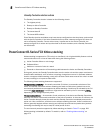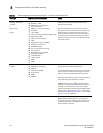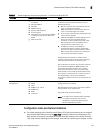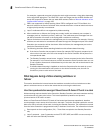
PowerConnect B-Series FCX Configuration Guide 159
53-1002266-01
More about IronStack technology
5
will recover their original startup-config.txt files and reboot as standalone devices. If you enter the
stack unconfigure all command from the Active Controller all devices will recover their old
startup-config.txt files and become standalone devices. When this happens, the startup-config.old
file is renamed to startup-config.txt, and the stacking.boot file is removed. For more information,
refer to “Unconfiguring an IronStack” on page 130.
Whenever a change is made to a stack unit's configuration, such as priority, (which could affect
stack elections) an election is held, and the result is written into the stacking.boot file. A prompt
message appears on the console that suggests you do a write memory. For an Active Controller role
change to take effect, you will need to reset the entire stack.
If you do not do a write memory, and reset the stack, the stack units will continue to operate in their
roles as defined by the stacking.boot file. After the reset, each unit readjusts based on the current
run time configuration. However, you may get different results depending on what has not been
saved. If you have renumbered the stack unit IDs, you may see a configuration mismatch, because
your changes no longer match the Active Controller configuration.
If you change priorities to elect an Active Controller, the new Active Controller will assume its role
after a reboot whether you have done a write memory or not. If you do not save your priority change
before the next reboot, the reboot will trigger an election that may result in a different winner based
on the priority in the unsaved configuration. The new winner assumes its role after the next reboot.
If you change the stacking port configuration and do not save your changes, you may encounter
connectivity errors. To recover from a configuration error, run Secure Startup to define the correct
stacking port.
NOTE
You should always do a write memory after making stacking-related configuration changes such as
priority and stacking ports. If you do not want to keep the changes, change the configuration back
to the previous version, and do a write memory. Do not discard configuration changes by using the
reset without a write memory.
IronStack topologies
IronStack technology supports both linear and ring stack topologies. Because the unicast switching
follows the shortest path in a ring topology, this topology offers the strongest redundancy. When the
ring is broken, the stack recalculates the forwarding path the resumes the flow of traffic within a
few seconds. In a ring topology, all stack members must have two stacking ports, however, In a
linear topology, both end units use only one stacking port, leaving the other port available as a data
port. To see an illustrated example of each topology, refer to “IronStack topologies” on page 98.
Port down and aging
If a unit is powered down, or the stacking link is removed, the system immediately detects the port
down and knows that its neighbor is gone. That unit is immediately removed from the Active
Controller. If a unit is gone or no longer stack-enabled, but its stacking link is still on, it will take 20
seconds to age the neighbor out. The following message will be logged and displayed.
Warning! my mac=00f0.424f.4243, age out up-stream
Device roles and elections
There are three distinct roles played by units that are part of an IronStack:



